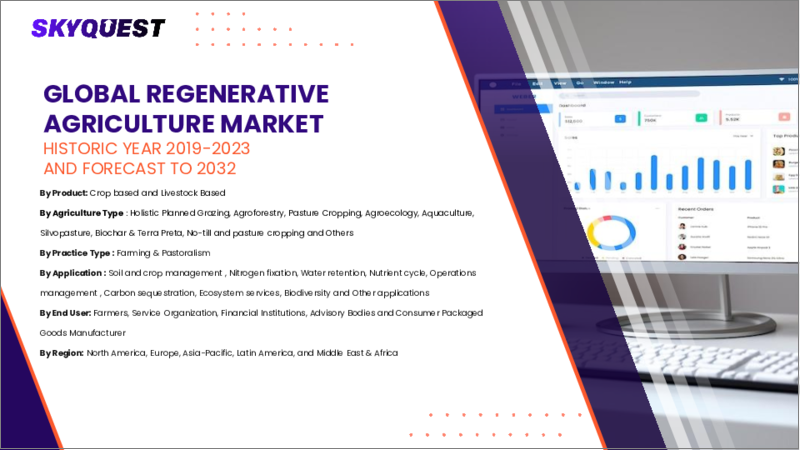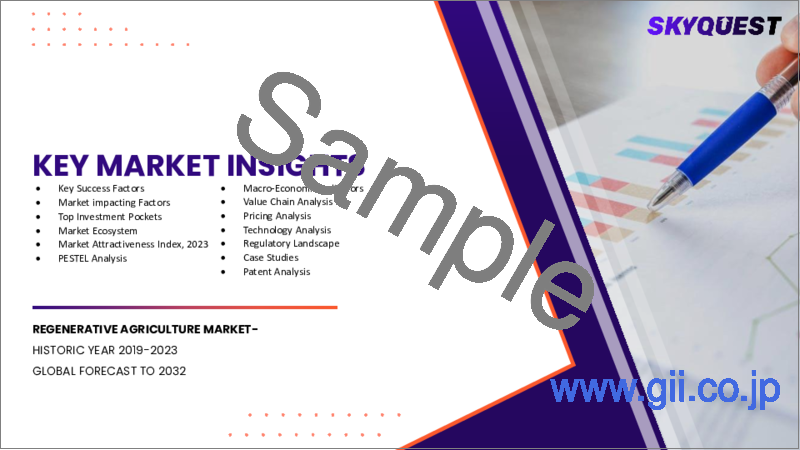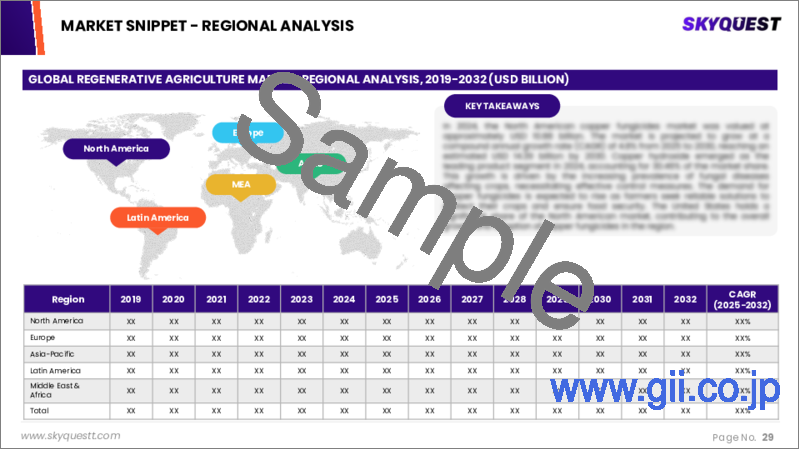|
|
市場調査レポート
商品コード
1614889
環境再生型農業の世界市場規模、シェア、成長分析:製品別、用途別、実践別、エンドユーザー別、地域別 - 産業予測(2024年~2031年)Regenerative Agriculture Market Size, Share, Growth Analysis, By Product (Crop Based, Livestock Based), By Application, By Practice, By End User, By Region - Industry Forecast 2024-2031 |
||||||
|
|||||||
| 環境再生型農業の世界市場規模、シェア、成長分析:製品別、用途別、実践別、エンドユーザー別、地域別 - 産業予測(2024年~2031年) |
|
出版日: 2024年12月14日
発行: SkyQuest
ページ情報: 英文 245 Pages
納期: 3~5営業日
|
全表示
- 概要
- 目次
世界の環境再生型農業の市場規模は、2022年に76億米ドルと評価され、2023年の89億米ドルから2031年には303億米ドルに成長し、予測期間(2024年~2031年)のCAGRは14.6%で成長する見通しです。
世界の環境再生型農業市場は、気候変動に対する懸念とともに、持続可能な農法に対する消費者の意識と嗜好の高まりによって、力強い成長を遂げています。この環境に優しいアプローチは生物多様性を重視し、野生動物や益虫をサポートする活気ある生態系を農場に育む一方、合成投入物への依存を最小限に抑えます。土壌の健全性の向上、炭素貯留量の増加、温室効果ガス排出量の削減といったメリットが、環境再生型の農法を魅力的なものにしています。しかし、農家、消費者、政策立案者の間には知識のギャップがあり、より広く普及させるための課題となっています。また、被覆作物や輪作作物などの実践に伴う初期費用は、中小規模の経営に負担をかける可能性があります。さらに、規制の枠組みや補助金が従来の方法を優遇していることが普及の妨げになることもあり、専門的なマーケティングや認証プロセスが小規模生産者のアクセスを制限することもあります。こうした障壁を克服し、長期的な成功を収めるためには、教育とトレーニングが不可欠です。
目次
イントロダクション
- 調査の目的
- 調査範囲
- 定義
調査手法
- 情報調達
- 二次・一次情報源
- 市場規模予測
- 市場の前提条件と制限
エグゼクティブサマリー
- 世界市場の見通し
- 供給と需要の動向分析
- セグメント別機会分析
市場力学と見通し
- 市場概要
- 市場規模
- 市場力学
- 促進要因と機会
- 抑制要因と課題
- ポーターの分析と影響
- 競争企業間の敵対関係
- 代替品の脅威
- 買い手の交渉力
- 新規参入業者の脅威
- 供給企業の交渉力
主な市場の考察
- 重要成功要因
- 競合の程度
- 主な投資機会
- 市場エコシステム
- 市場の魅力指数(2023年)
- PESTEL分析
- マクロ経済指標
- バリューチェーン分析
- 価格分析
- 技術の進歩
- 規制情勢
- ケーススタディ
- 特許分析
環境再生型農業市場規模:製品別、CAGR(2024年~2031年)
- 市場概要
- 作物ベース
- 畜産ベース
環境再生型農業市場規模:用途別、CAGR(2024年~2031年)
- 市場概要
- 農業
- 牧畜
環境再生型農業市場規模:実践別、CAGR(2024年~2031年)
- 市場概要
- 総合的な計画放牧
- 農林業
- 牧草栽培
- 農業生態学
- 養殖業
- 森林牧草地
- その他
環境再生型農業市場規模:エンドユーザー別、CAGR(2024年~2031年)
- 市場概要
- 農家
- サービス組織
- 金融機関
- 諮問機関
- 消費財メーカー
環境再生型農業市場規模、CAGR(2024年~2031年)
- 北米
- 米国
- カナダ
- 欧州
- 英国
- ドイツ
- スペイン
- フランス
- イタリア
- その他欧州
- アジア太平洋
- 中国
- インド
- 日本
- 韓国
- その他アジア太平洋
- ラテンアメリカ
- ブラジル
- その他ラテンアメリカ
- 中東・アフリカ
- GCC諸国
- 南アフリカ
- その他中東・アフリカ
競合情報
- 上位5社の比較
- 主要企業の市場ポジショニング(2023年)
- 主な市場企業が採用した戦略
- 市場の最近の動向
- 企業の市場シェア分析(2023年)
- 主要企業プロファイル
- 会社概要
- 製品ポートフォリオ分析
- セグメント別シェア分析
- 収益の前年比の比較(2021年~2023年)
主要企業プロファイル
- General Mills Inc.(USA)
- Danone S.A.(France)
- Nestle S.A.(Switzerland)
- Cargill, Inc.(USA)
- Alter Eco Americas, Inc.(USA)
- Bluebird Grain Farms(USA)
- CIBO Technologies(USA)
- Continuum Ag(USA)
- EcoFarm(South Africa)
- Grounded South Africa(South Africa)
- RegenAG(Australia)
- Regeneration Canada(Canada)
- Soil Capital Ltd.(UK)
- White Oak Pastures(USA)
- Green Cover(USA)
- Propagate Ventures(USA)
- VIRENXIA(India)
- Community Alliance with Family Farmers(CAFF)(USA)
- Carbon Underground(USA)
- Mad Agriculture(USA)
結論と推奨事項
Global Regenerative Agriculture Market size was valued at USD 7.6 billion in 2022 and is poised to grow from USD 8.9 billion in 2023 to USD 30.3 billion by 2031, growing at a CAGR of 14.6% during the forecast period (2024-2031).
The global regenerative agriculture market is witnessing robust growth, driven by rising consumer awareness and preference for sustainable farming practices alongside concerns over climate change. This eco-friendly approach emphasizes biodiversity, fostering vibrant ecosystems on farms that support wildlife and beneficial insects while minimizing dependence on synthetic inputs. Benefits such as enhanced soil health, increased carbon sequestration, and reduced greenhouse gas emissions make regenerative practices attractive. However, knowledge gaps among farmers, consumers, and policymakers pose challenges to wider adoption. Upfront costs associated with practices like cover cropping and crop rotation can strain small and medium-sized operations. Additionally, regulatory frameworks and subsidies favoring conventional methods may hinder progress, while specialized marketing and certification processes can limit access for smaller producers. Education and training are crucial for overcoming these barriers and achieving long-term success in regenerative agriculture.
Top-down and bottom-up approaches were used to estimate and validate the size of the Global Regenerative Agriculture market and to estimate the size of various other dependent submarkets. The research methodology used to estimate the market size includes the following details: The key players in the market were identified through secondary research, and their market shares in the respective regions were determined through primary and secondary research. This entire procedure includes the study of the annual and financial reports of the top market players and extensive interviews for key insights from industry leaders such as CEOs, VPs, directors, and marketing executives. All percentage shares split, and breakdowns were determined using secondary sources and verified through Primary sources. All possible parameters that affect the markets covered in this research study have been accounted for, viewed in extensive detail, verified through primary research, and analyzed to get the final quantitative and qualitative data.
Global Regenerative Agriculture Market Segmental Analysis
Global Regenerative Agriculture Market is segmented by Product, Application, Practice, End User and Region. Based on Product, the market is segmented into Crop Based, Livestock Based Product. Based on Application, the market is segmented into Farming and Pastoralism. Based on Practice, the market is segmented into Holistic Planned Grazing, Agroforestry, Pasture Cropping, Agroecology, Aquaculture, Silvopasture, Others. Based on Segment 4, the market is segmented into Farmers, Service Organization, Financial Institutions, Advisory Bodies, Consumer Packaged Goods Manufacturer. Based on Region, the market is segmented into North America, Europe, Asia Pacific, Latin America and Middle East & Africa.
Driver of the Global Regenerative Agriculture Market
The global Regenerative Agriculture market is significantly driven by the rising consumer demand for sustainable farming practices. As individuals become more aware of environmental issues, they actively seek out food produced through ethical and sustainable methods. This growing preference has propelled the adoption of regenerative agriculture, which is increasingly recognized as a more sustainable and eco-friendly farming approach. Consumers are often willing to pay higher prices for products cultivated using regenerative practices, motivating more farmers to embrace these methods. Additionally, many companies are investing in regenerative agriculture to align with consumer values and enhance their sustainability credentials, further boosting the market.
Restraints in the Global Regenerative Agriculture Market
One of the key restraints facing the Global Regenerative Agriculture market is the substantial initial investment required for implementation. Farmers must allocate significant funds for infrastructure and equipment essential for practices like planting cover crops, enhancing soil health, and shifting away from conventional farming methods. This economic burden can be particularly challenging for smallholder farmers who often struggle to secure the necessary capital. As a result, the considerable upfront costs can deter the adoption of regenerative agriculture techniques, ultimately impeding the overall growth of the market and limiting its potential reach among agricultural stakeholders.
Market Trends of the Global Regenerative Agriculture Market
The Global Regenerative Agriculture market is witnessing a robust trend driven by the surging consumer demand for organic and natural food products. As health-conscious and environmentally aware consumers increasingly prioritize sustainably produced goods, regenerative agriculture practices-known for enhancing soil health and biodiversity-are gaining prominence. Food producers and retailers are increasingly aligning their sourcing strategies to include ingredients from regenerative farms, and many are actively investing in these practices to enhance their product offerings. This market momentum is poised to accelerate, fueled by heightened consumer awareness of regenerative agriculture's benefits, thereby solidifying its role in the future of sustainable food production.
Table of Contents
Introduction
- Objectives of the Study
- Scope of the Report
- Definitions
Research Methodology
- Information Procurement
- Secondary & Primary Data Methods
- Market Size Estimation
- Market Assumptions & Limitations
Executive Summary
- Global Market Outlook
- Supply & Demand Trend Analysis
- Segmental Opportunity Analysis
Market Dynamics & Outlook
- Market Overview
- Market Size
- Market Dynamics
- Driver & Opportunities
- Restraints & Challenges
- Porters Analysis & Impact
- Competitive rivalry
- Threat of substitute
- Bargaining power of buyers
- Threat of new entrants
- Bargaining power of suppliers
Key Market Insights
- Key Success Factors
- Degree of Competition
- Top Investment Pockets
- Market Ecosystem
- Market Attractiveness Index, 2023
- PESTEL Analysis
- Macro-Economic Indicators
- Value Chain Analysis
- Pricing Analysis
- Technological Advancement
- Regulatory Landscape
- Case Studies
- Patent Analysis
Regenerative Agriculture Market Size by Product & CAGR (2024-2031)
- Market Overview
- Crop based
- Livestock Based
Regenerative Agriculture Market Size by Application & CAGR (2024-2031)
- Market Overview
- Farming
- Pastoralism
Regenerative Agriculture Market Size by Practice & CAGR (2024-2031)
- Market Overview
- Holistic Planned Grazing
- Agroforestry
- Pasture Cropping
- Agroecology
- Aquaculture
- Silvopasture
- Others
Regenerative Agriculture Market Size by End User & CAGR (2024-2031)
- Market Overview
- Farmers
- Service Organization
- Financial Institutions
- Advisory Bodies
- Consumer Packaged Goods Manufacturer
Regenerative Agriculture Market Size & CAGR (2024-2031)
- North America (Product, Application, Practice, End User)
- US
- Canada
- Europe (Product, Application, Practice, End User)
- UK
- Germany
- Spain
- France
- Italy
- Rest of Europe
- Asia-Pacific (Product, Application, Practice, End User)
- China
- India
- Japan
- South Korea
- Rest of Asia Pacific
- Latin America (Product, Application, Practice, End User)
- Brazil
- Rest of Latin America
- Middle East & Africa (Product, Application, Practice, End User)
- GCC Countries
- South Africa
- Rest of Middle East & Africa
Competitive Intelligence
- Top 5 Player Comparison
- Market Positioning of Key Players, 2023
- Strategies Adopted by Key Market Players
- Recent Developments in the Market
- Company Market Share Analysis, 2023
- Company Profiles of All Key Players
- Company Details
- Product Portfolio Analysis
- Company's Segmental Share Analysis
- Revenue Y-O-Y Comparison (2021-2023)
Key Company Profiles
- General Mills Inc. (USA)
- Company Overview
- Business Segment Overview
- Financial Updates
- Key Developments
- Danone S.A. (France)
- Company Overview
- Business Segment Overview
- Financial Updates
- Key Developments
- Nestle S.A. (Switzerland)
- Company Overview
- Business Segment Overview
- Financial Updates
- Key Developments
- Cargill, Inc. (USA)
- Company Overview
- Business Segment Overview
- Financial Updates
- Key Developments
- Alter Eco Americas, Inc. (USA)
- Company Overview
- Business Segment Overview
- Financial Updates
- Key Developments
- Bluebird Grain Farms (USA)
- Company Overview
- Business Segment Overview
- Financial Updates
- Key Developments
- CIBO Technologies (USA)
- Company Overview
- Business Segment Overview
- Financial Updates
- Key Developments
- Continuum Ag (USA)
- Company Overview
- Business Segment Overview
- Financial Updates
- Key Developments
- EcoFarm (South Africa)
- Company Overview
- Business Segment Overview
- Financial Updates
- Key Developments
- Grounded South Africa (South Africa)
- Company Overview
- Business Segment Overview
- Financial Updates
- Key Developments
- RegenAG (Australia)
- Company Overview
- Business Segment Overview
- Financial Updates
- Key Developments
- Regeneration Canada (Canada)
- Company Overview
- Business Segment Overview
- Financial Updates
- Key Developments
- Soil Capital Ltd. (UK)
- Company Overview
- Business Segment Overview
- Financial Updates
- Key Developments
- White Oak Pastures (USA)
- Company Overview
- Business Segment Overview
- Financial Updates
- Key Developments
- Green Cover (USA)
- Company Overview
- Business Segment Overview
- Financial Updates
- Key Developments
- Propagate Ventures (USA)
- Company Overview
- Business Segment Overview
- Financial Updates
- Key Developments
- VIRENXIA (India)
- Company Overview
- Business Segment Overview
- Financial Updates
- Key Developments
- Community Alliance with Family Farmers (CAFF) (USA)
- Company Overview
- Business Segment Overview
- Financial Updates
- Key Developments
- Carbon Underground (USA)
- Company Overview
- Business Segment Overview
- Financial Updates
- Key Developments
- Mad Agriculture (USA)
- Company Overview
- Business Segment Overview
- Financial Updates
- Key Developments






